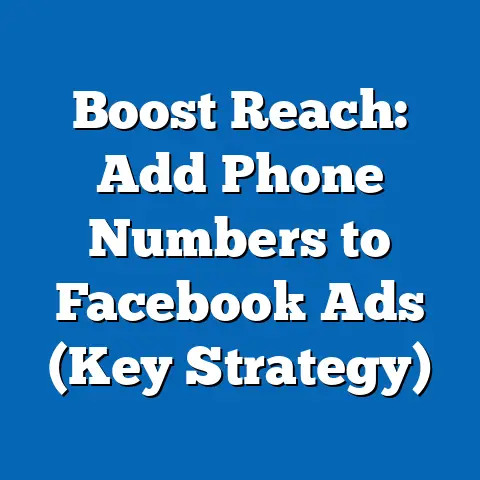Streamline Facebook Page with Admins (Expert Tips)
Managing a Facebook page, especially one with a growing community, can quickly become overwhelming. I remember when I first started my page, “Crafty Creations,” a hobby blog showcasing my DIY projects. I was a one-woman show, juggling content creation, responding to comments, and trying to understand the ever-changing algorithms. It wasn’t long before I realized I needed help, but simply adding people as admins didn’t magically solve my problems. Instead, it created new ones: inconsistent posting schedules, conflicting responses to customer inquiries, and a general lack of cohesive strategy. One particularly memorable incident involved two admins scheduling competing posts within minutes of each other, completely overwhelming our audience! That’s when I understood the crucial need for a structured approach to managing a Facebook page with a well-defined team of admins. In this guide, I’ll share my hard-earned expert tips on how to streamline your Facebook page management, build a cohesive admin team, and ultimately, achieve greater success.
Section 1: The Importance of Having a Structured Admin Team
Think of your Facebook page as a ship sailing towards a specific destination: increased brand awareness, lead generation, or boosting sales. Without a captain (a clear leader) and a crew with defined roles, the ship will likely drift aimlessly. That’s precisely what happens to many Facebook pages with poorly managed admin teams.
A structured admin team brings several key benefits:
- Increased Efficiency: When everyone knows their responsibilities, tasks are completed faster and with less confusion. This means more time dedicated to strategic initiatives rather than firefighting.
- Improved Consistency: Having defined guidelines ensures a consistent brand voice and message across all interactions, building trust and recognition with your audience.
- Enhanced Engagement: A well-coordinated team can respond promptly to comments and messages, fostering a sense of community and building stronger relationships with followers.
- Data-Driven Decisions: By assigning admins to track and analyze key metrics, you can gain valuable insights into what’s working and what’s not, allowing you to optimize your strategy for maximum impact.
- Reduced Burnout: Spreading the workload among multiple admins prevents any single person from becoming overwhelmed, ensuring long-term sustainability.
I’ve seen firsthand how a lack of structure can cripple a Facebook page. I consulted for a local bakery that had a passionate but disorganized team of admins. They were constantly stepping on each other’s toes, leading to missed opportunities and frustrated customers. After implementing a clear structure with defined roles (content creation, customer service, analytics), they saw a 30% increase in engagement and a significant improvement in customer satisfaction.
According to a recent study by Social Media Examiner, businesses with a documented social media strategy are 539% more likely to report success. While this statistic encompasses all social media platforms, the principle remains the same: structure and planning are essential for success on Facebook.
Takeaway: A structured admin team is not just a nice-to-have; it’s a necessity for efficient, consistent, and data-driven Facebook page management.
Section 2: Identifying the Right Admins for Your Page
Choosing the right admins is like building a winning sports team. You need individuals with the right skills, experience, and personality to complement each other and contribute to a common goal. Don’t just add your friends or family members because they’re willing to help; carefully consider their qualifications and how they align with your brand.
Here’s a breakdown of the key criteria:
Skills: What Skills Are Essential for an Admin?
- Content Creation: The ability to create engaging and visually appealing content is crucial. This includes writing compelling copy, designing eye-catching graphics, and producing high-quality videos. Look for individuals with experience in copywriting, graphic design, photography, or videography.
- Community Management: A community manager is responsible for fostering a positive and engaging environment on your page. They should be skilled at responding to comments and messages promptly, resolving conflicts constructively, and building relationships with followers. Excellent communication and interpersonal skills are essential.
- Customer Service: If your Facebook page is used for customer support, you’ll need admins with experience in handling customer inquiries and resolving complaints. They should be patient, empathetic, and knowledgeable about your products or services.
- Data Analysis: Understanding Facebook Insights and other analytics tools is crucial for tracking performance and making data-driven decisions. Look for individuals with experience in data analysis, marketing analytics, or business intelligence.
- Technical Proficiency: A basic understanding of Facebook’s features and settings is essential for all admins. They should be comfortable navigating the platform, managing permissions, and troubleshooting technical issues.
Experience: How Past Experiences Can Influence Admin Performance
- Social Media Marketing: Experience in managing other social media accounts can be a valuable asset. Look for individuals who have a proven track record of growing followers, increasing engagement, and driving results.
- Content Marketing: Experience in creating and distributing valuable, relevant, and consistent content can help you attract and retain a clearly defined audience.
- Customer Service: Prior experience in customer service roles can equip admins with the skills to handle challenging customer interactions effectively.
- Project Management: Experience in managing projects and coordinating teams can help ensure that tasks are completed on time and within budget.
Personality: Describe the Importance of Having Admins Who Align with Your Brand’s Voice and Values
- Brand Alignment: Admins should understand and embody your brand’s voice, values, and personality. They should be able to communicate in a way that is consistent with your brand’s overall messaging.
- Positive Attitude: A positive and enthusiastic attitude is contagious and can help create a more engaging and welcoming environment on your page.
- Problem-Solving Skills: The ability to think critically and solve problems creatively is essential for handling unexpected situations and resolving conflicts.
- Team Player: Admins should be able to work collaboratively with other team members, sharing ideas, providing support, and contributing to a common goal.
Onboarding New Admins and Setting Expectations
Once you’ve identified the right individuals, it’s crucial to onboard them properly and set clear expectations. This includes:
- Providing a comprehensive training manual: This manual should outline your brand’s voice, values, guidelines, and responsibilities.
- Scheduling regular training sessions: These sessions can be used to review best practices, answer questions, and provide ongoing support.
- Setting clear performance goals: These goals should be specific, measurable, achievable, relevant, and time-bound (SMART).
- Providing regular feedback: Give admins regular feedback on their performance, both positive and constructive.
When I brought on my first admin for “Crafty Creations,” I made the mistake of assuming they understood my brand as well as I did. I quickly realized that wasn’t the case. Their posting style was completely different from mine, and they often missed opportunities to engage with followers. I learned the hard way that clear communication and thorough training are essential for success.
Takeaway: Choosing the right admins is a critical step in streamlining your Facebook page management. Focus on skills, experience, and personality, and invest in proper onboarding and training.
Section 3: Setting Clear Guidelines and Responsibilities
Imagine a group of chefs working in a kitchen without recipes or instructions. Chaos would ensue! The same is true for a Facebook page without clear guidelines and responsibilities. Each admin needs to understand their specific role, the expectations for their performance, and the rules they need to follow.
- Posting Frequency: Define how often each admin should post content. This will help maintain a consistent flow of information without overwhelming your audience.
- Tone and Style of Communication: Establish the desired tone and style for all interactions with followers. Should it be formal or informal? Humorous or serious?
- Response Times: Set expectations for how quickly admins should respond to comments and messages. Prompt responses demonstrate that you value your audience’s time and engagement.
- Types of Content Permitted: Specify the types of content that are allowed on the page. This will help prevent inappropriate or off-brand content from being published.
- Image and Video Guidelines: Provide guidelines for the types of images and videos that should be used on the page. This includes resolution, file size, and branding elements.
- Hashtag Usage: Define which hashtags should be used on posts to increase visibility and reach.
- Contest and Giveaway Rules: Outline the rules and regulations for running contests and giveaways on the page.
- Crisis Communication Plan: Develop a plan for handling negative comments, complaints, or other potential crises.
The Importance of Having a Shared Vision and Mission Statement for Your Facebook Page
A shared vision and mission statement provides a sense of purpose and direction for your admin team. It helps everyone understand the overall goals of the page and how their individual contributions contribute to the bigger picture.
Section 4: Tools and Software to Streamline Admin Tasks
In today’s digital world, there’s no need to rely solely on manual processes. A wide range of tools and software can significantly streamline admin tasks, saving time and improving efficiency.
Content Scheduling Tools (e.g., Buffer, Hootsuite)
- Buffer: Buffer allows you to schedule posts across multiple social media platforms, including Facebook. It also provides analytics to track your performance and optimize your strategy.
- Hootsuite: Hootsuite is another popular social media management tool that allows you to schedule posts, monitor conversations, and analyze your performance. It also offers team collaboration features, making it easier for admins to work together.
- Sprout Social: Sprout Social is a more advanced social media management tool that offers a wide range of features, including social listening, customer relationship management, and reporting.
- Later: Later is primarily focused on Instagram scheduling, but it also allows you to schedule posts to Facebook. It’s particularly useful for visually driven brands.
Step-by-Step Guide on Integrating Content Scheduling Tools:
- Choose a tool: Research and select a content scheduling tool that meets your needs and budget.
- Create an account: Sign up for an account and connect your Facebook page.
- Schedule your posts: Create your content and schedule it to be published at optimal times.
- Monitor your performance: Track your analytics to see which posts are performing well and adjust your strategy accordingly.
Analytics Tools (Facebook Insights, Google Analytics)
- Facebook Insights: Facebook Insights provides detailed data about your page’s performance, including reach, engagement, and demographics.
- Google Analytics: Google Analytics allows you to track traffic to your website from Facebook and other sources. It provides valuable insights into user behavior, such as bounce rate, time on site, and conversion rates.
Step-by-Step Guide on Integrating Analytics Tools:
- Connect Google Analytics to your website: Follow Google’s instructions to connect your website to Google Analytics.
- Track Facebook traffic: Use UTM parameters to track traffic to your website from Facebook.
- Analyze your data: Use Facebook Insights and Google Analytics to analyze your data and identify areas for improvement.
Collaboration Tools (Trello, Slack)
- Trello: Trello is a project management tool that allows you to organize tasks, track progress, and collaborate with your team.
- Slack: Slack is a messaging app that allows you to communicate with your team in real-time. It also integrates with other tools, such as Trello and Google Drive.
- Asana: Asana is another project management tool that offers similar features to Trello.
- Google Workspace (formerly G Suite): Google Workspace includes a suite of tools, such as Gmail, Google Drive, and Google Calendar, that can help you collaborate with your team.
Step-by-Step Guide on Integrating Collaboration Tools:
- Choose a tool: Select a collaboration tool that meets your team’s needs.
- Create a workspace: Create a workspace for your Facebook page management team.
- Invite your admins: Invite your admins to join the workspace.
- Organize your tasks: Create boards or channels to organize your tasks and projects.
- Communicate effectively: Use the tool to communicate with your team, share updates, and collaborate on projects.
I remember when my admin team was scattered across different platforms, using email, text messages, and Facebook Messenger to communicate. It was a chaotic mess! After implementing Slack, our communication became much more organized and efficient. We were able to create dedicated channels for different topics, share files easily, and track progress on projects.
Takeaway: Leveraging the right tools and software can significantly streamline admin tasks, saving time, improving efficiency, and enhancing collaboration.
Section 5: Communication Strategies Among Admins
Effective communication is the lifeblood of any successful team, especially a Facebook page admin team. Without clear and consistent communication, misunderstandings can arise, tasks can be duplicated, and opportunities can be missed.
Emphasize the Importance of Regular Communication Between Admins
Regular communication helps ensure that everyone is on the same page, aware of current priorities, and able to address any challenges that may arise.
Suggest Methods for Maintaining an Open Line of Communication (e.g., Weekly Check-ins, Group Chats)
- Weekly Check-ins: Schedule weekly meetings to discuss progress, address challenges, and plan for the upcoming week.
- Group Chats: Create a group chat using a messaging app like Slack or WhatsApp to facilitate real-time communication and quick updates.
- Project Management Tools: Use project management tools like Trello or Asana to track tasks, assign responsibilities, and monitor progress.
- Email Updates: Send out regular email updates summarizing key activities, achievements, and upcoming events.
Provide Tips on How to Resolve Conflicts or Disagreements Among Admins Quickly and Constructively
- Active Listening: Encourage admins to listen actively to each other’s perspectives and try to understand their point of view.
- Focus on Solutions: Encourage admins to focus on finding solutions rather than dwelling on the problem.
- Mediation: If conflicts escalate, consider bringing in a neutral third party to mediate the discussion.
- Compromise: Encourage admins to be willing to compromise and find mutually agreeable solutions.
- Respectful Communication: Emphasize the importance of communicating respectfully, even when disagreeing with someone.
I’ve seen countless instances where a lack of communication led to unnecessary conflicts and missed opportunities. For example, two admins might unknowingly schedule competing posts at the same time, or one admin might make a decision that contradicts a previous decision made by another admin. Regular communication can prevent these types of issues from arising.
Takeaway: Effective communication is essential for a successful Facebook page admin team. Encourage regular communication, provide tools and channels for communication, and teach admins how to resolve conflicts constructively.
Section 6: Monitoring Performance and Adjusting Strategies
Managing a Facebook page is not a set-it-and-forget-it operation. It requires constant monitoring, analysis, and adjustment to ensure that you’re achieving your goals and maximizing your impact.
Discuss How to Regularly Assess the Performance of Your Facebook Page
Regularly assessing your page’s performance allows you to identify what’s working, what’s not, and where you need to make adjustments.
Highlight Key Performance Indicators (KPIs) That Admins Should Focus On, Such as Engagement Rates, Follower Growth, and Response Times
- Engagement Rate: This measures the level of interaction your audience has with your content. It’s calculated by dividing the total number of engagements (likes, comments, shares) by the total reach of your posts.
- Follower Growth: This measures the rate at which your page is gaining new followers.
- Reach: This measures the number of unique people who have seen your content.
- Website Traffic: This measures the amount of traffic to your website from Facebook.
- Conversion Rate: This measures the percentage of visitors who take a desired action, such as making a purchase or signing up for a newsletter.
- Response Time: This measures the average time it takes for admins to respond to comments and messages.
Explain How to Use Insights Gained from Performance Metrics to Refine Strategies and Improve Page Management
By analyzing your KPIs, you can gain valuable insights into what’s working and what’s not. For example, if you notice that your engagement rate is low, you might need to experiment with different types of content, posting times, or targeting options. If you notice that your website traffic is low, you might need to optimize your calls to action or improve the relevance of your content.
I once worked with a clothing retailer that was struggling to generate sales through their Facebook page. After analyzing their KPIs, we discovered that their engagement rate was low and their website traffic was minimal. We experimented with different types of content, posting times, and targeting options, and we saw a significant improvement in their performance. We also optimized their calls to action and improved the relevance of their content, which led to a dramatic increase in website traffic and sales.
Takeaway: Monitoring your page’s performance and adjusting your strategies based on data is essential for achieving your goals and maximizing your impact. Focus on key performance indicators, analyze your data regularly, and be willing to experiment with different approaches.
Section 7: Case Studies and Expert Insights
Learning from the successes and failures of others can provide valuable insights and inspiration.
Share Real-Life Examples of Brands or Businesses That Have Effectively Streamlined Their Facebook Page Management Through a Strong Admin Team
- Nike: Nike’s Facebook page is managed by a team of experts who create engaging content, respond to comments promptly, and maintain a consistent brand voice.
- Coca-Cola: Coca-Cola’s Facebook page is managed by a team of experts who focus on building relationships with their audience, creating a sense of community, and promoting their brand values.
- Red Bull: Red Bull’s Facebook page is managed by a team of experts who create visually stunning content, share exciting stories, and engage with their audience in a unique and memorable way.
Include Quotes or Insights from Industry Experts Regarding Best Practices for Managing Facebook Pages
- “The key to success on Facebook is to provide valuable content, engage with your audience, and build relationships.” – Mari Smith, Social Media Expert
- “Don’t just post content; create experiences.” – Gary Vaynerchuk, Entrepreneur and Social Media Influencer
- “Focus on quality over quantity.” – Neil Patel, Digital Marketing Expert
Takeaway: Learning from the successes and failures of others can provide valuable insights and inspiration for streamlining your Facebook page management. Study successful examples, listen to expert advice, and adapt their strategies to your own unique circumstances.
Conclusion
Managing a Facebook page effectively requires more than just posting content. It requires a structured admin team, clear guidelines, effective communication, and constant monitoring and adjustment. By following the expert tips outlined in this guide, you can streamline your Facebook page management, build a cohesive admin team, and ultimately, achieve greater success.
Remember my “Crafty Creations” page? After implementing these strategies, the chaos transformed into a well-oiled machine. Our engagement soared, our community grew, and I finally had time to focus on what I loved most: creating! Don’t let your Facebook page become a source of stress and frustration. Take the actionable steps outlined in this article, and start building a streamlined, successful Facebook presence today. The potential for growth and engagement is waiting to be unlocked.






